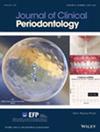Three-Year Outcomes of Dental Implants With a Hybrid Surface Macro-Design Placed in Patients With History of Periodontitis: A Randomised Clinical Trial
Abstract
Aim
This randomised controlled trial (RCT) with a 3-year follow-up was aimed at assessing the clinical and radiographic outcomes of implants with either a hybrid or moderately rough macro-surface design placed in patients with a history of periodontitis.
Material and Methods
Forty periodontitis subjects with a stable periodontal condition were included and randomly assigned to receive either a hybrid implant with a machined-collar surface (HS) or a conventional implant with a moderately rough-collar surface up to the shoulder (RS). Radiographic, clinical, microbiological and patient-related outcome measurements (PROMs) were assessed at baseline (implant loading) and 3, 6, 12, 24 and 36 months post-loading.
Results
Thirty-six patients (17 and 19, in the test and control groups, respectively) completed the three-year follow-up. At this visit, mean marginal bone level (MBL) changes were −0.08 (SD 0.2) and 0.02 (SD 0.28) mm for the test and control groups, respectively, with only three patients exhibiting MBLs exceeding 1 mm and only one implant with a peri-implantitis diagnosis. Patients in both groups showed a high degree of satisfaction, and implants in both groups harboured a similar proportion and counts of measured periodontal pathogens. No significant differences were observed between the two groups regarding any of the radiographic, clinical or microbiological variables.
Conclusions
At the three-year follow-up, both implant groups demonstrated high peri-implant bone stability, as well as a low incidence of peri-implant diseases.
Trial Registration: ClinicalTrials.gov (identifier NCT05010382). https://clinicaltrials.gov/ct2/show/NCT05010382?cond=peri-implantitis&cntry=ES&city=Madrid&draw=2&rank=5

 求助内容:
求助内容: 应助结果提醒方式:
应助结果提醒方式:


